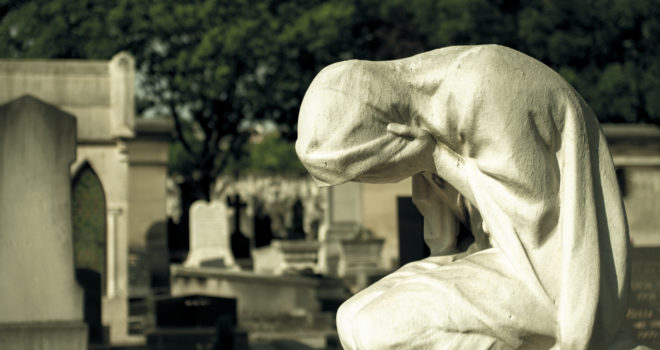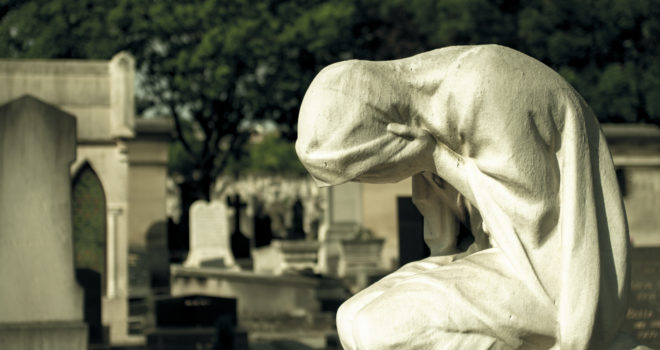Years ago, I remember reading a book written by an evangelical, fundamentalist Christian. In it, the woman described being an exhausted, sleep deprived mother to many and being up late one night doing laundry. She said that she began to break down and cry from sheer exhaustion. Then, she said that she stopped and realized that she should start singing hymns of praise instead – and she felt immediately better.
I have heard a similar sentiment expressed by other Christians, too (even some Catholic Christians) – that in suffering and adversity, a true sign of faith was praising God despite it. Many will share something hard they’re going through, but quickly follow it with something along the lines of, “God is good all the time!” They often express concern that not praising God and rejoicing in the midst of suffering displays a lack of faith.
And yet, Mary shows us a different way – a way that is in imitation of her Son.
Stabat Mater
The well-known Lenten Marian hymn is called “Stabat Mater” not “Joyful Mother.” At the foot of the cross, Mary was not singing praise songs. Nor was her Son, whose prayer was, “My God, my God, why have you abandoned me?”
When confronted with the image of Mary – the holiest human (that possessed no divine nature) that ever lived – at the foot of the cross, we are confronted with her tears. There is a significance to the sorrowing of Mary over the death of her Son. Surely, her faith was greater than any other Christians ever could be, she who believed that the word the angel Gabriel had spoken would come to be true. In her tears was not a lack of faith, but rather an excess of love. She undoubtedly trusted, fully, that the death of her Son would bring about the will of God in a way she could not yet understand. Yet, she loved him, and she united herself fully to his suffering on the cross. When one loves that deeply, and the focus of that love is suffering – it is impossible not to suffer, too.
Suffering in Union
Every saint suffered. If you think over the lives of the saints, in fact, it seems that many of them suffered even more than the average person. There is no canonized saint who lived a comfortable, happy life, then died peacefully in old age. St. Teresa of Avila summarized it best with her prayer, “God, if this is how you treat your friends…it’s no wonder that you have so few of them!”
Why is this?
This reality flies in the face of the so-called “prosperity Gospel.” Proponents of the prosperity Gospel mentality claim that God rewards great faith with material blessings. If you are suffering, these preachers claim, it is simply a sign of your lack of faith. “Have you prayed for it? If you pray for those blessings, God will give them to you!” Yet, the lives of canonized saints tell a different story. The greater the saint’s faith, the more he or she suffered. Most saints were not wealthy or possess material prosperity. Most were poor or struggling or were a member of the wealthy who constantly gave away their wealth.
The answer is found in the analogy of marriage.
I remember the first time my husband and I had an argument after we got married. We had disagreed before our wedding, as all normal couples do, but in those previous arguments, I felt no qualms in trying to make him feel bad for not seeing things the way that I did. But then, in this first marital disagreement, I stopped in my tracks and looked at him. I found that even the thought of trying to make him feel guilty or bad caused my own heart pain. I could not cause him pain without feeling his pain myself. I looked at him and said, “I was going to try to make you feel bad, but I can’t – because when you hurt, I hurt.” We have now been married for thirteen years and have experienced our fair share of suffering and disagreements, but it still holds true – when he suffers, I suffer (and vice versa).
When you experience real union with your spouse, you suffer when the other suffers. You can not rejoice when they are weeping, even if you believe that God will use their suffering for good.
Jesus is the Divine Bridegroom. The Bride longs to embrace her Bridegroom, and he longs to embrace her. Yet, at the moment when this Bridegroom is loving in the greatest way possible – he is hanging on the cross. If the Bride (each of us in the Church and the Church as a whole) is to draw near enough in union with the Bridegroom to embrace him – she cannot be untouched by his suffering. To be in union with the Bridegroom, you must join him on the cross.
Holiness in Tears
Mary emulates for all of us an appropriate, holy response to suffering – tears. In union with the suffering of her Son – who she loved with all of her heart – she suffered at the foot of the cross. She didn’t dismiss that suffering with a forced smile, or singing, or shouting, “God is good, all the time!” Rather, she wept. And John – representing all of the Church – wept with her.
In weeping is not a lack of faith, but rather an excess of love.
In weeping is also an excess of trust. Most people can only weep with someone they feel safe to be vulnerable with. When, in our suffering, we bring God the gift of our tears, we are not lacking in faith. Rather, we are living out and allowing him to deepen our faith – trusting him with our tears in the way a child does who runs to a parent in tears.
It is okay to be sorrowful in the face of suffering. In fact, it is more than okay – it can be a step on the path to holiness, if that sorrow is entrusted to God, just as Mary’s was.
✠












